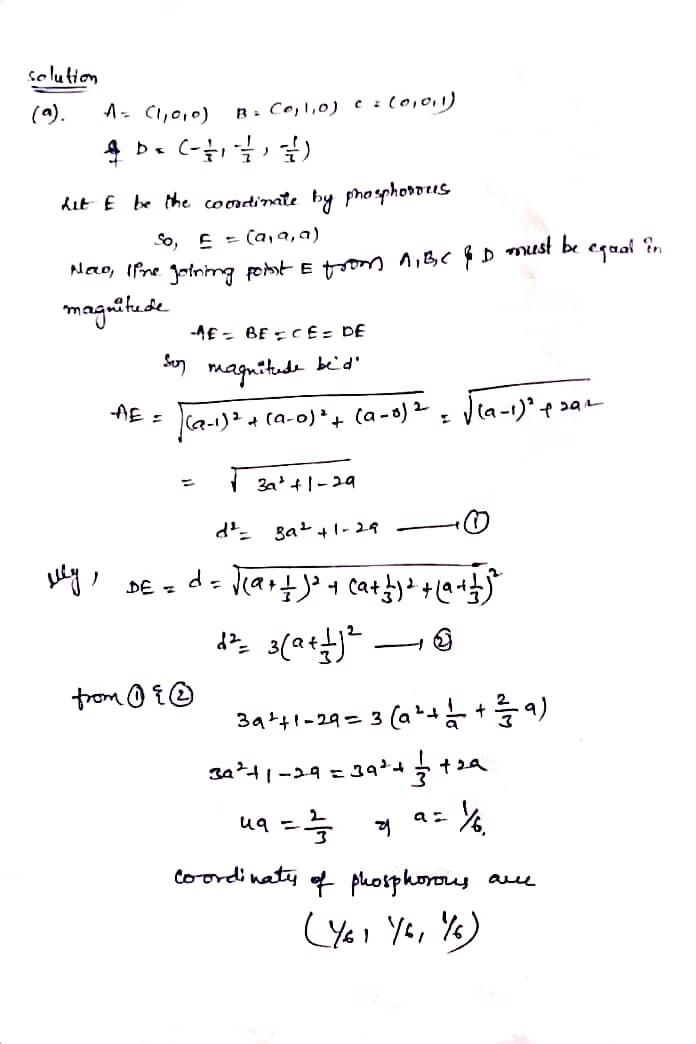1. Stable molecules form when atoms arrange in a way to exert equal force on each other. One such molecule is phosphate, PO, which forms a tetrahedron shape. The notation indicates 4 oxygen atoms with a single phosphorus atom (and an overall excess of 3 electrons). Consider a coordinate system where the four oxygen atoms that form the tetrahedron are placed at (1,0,0), (0, 1,0), (0, 0, 1), and (-1/3, -1/3, -1/3). (a) To have equal forces the phosphate atom must be placed equidistant from each of the oxygen atoms. Assume the phosphorus atom has the same value for all coordinates, i.e. it is located at (a, a, a). Find a. (b) Determine the bond angle, that is the angle between the lines that join the phosphorus atom to two of the oxygen atoms. Estimate it in degrees.
1. Stable molecules form when atoms arrange in a way to exert equal force on each other. One such molecule is phosphate, PO, which forms a tetrahedron shape. The notation indicates 4 oxygen atoms with a single phosphorus atom (and an overall excess of 3 electrons). Consider a coordinate system where the four oxygen atoms that form the tetrahedron are placed at (1,0,0), (0, 1,0), (0, 0, 1), and (-1/3, -1/3, -1/3). (a) To have equal forces the phosphate atom must be placed equidistant from each of the oxygen atoms. Assume the phosphorus atom has the same value for all coordinates, i.e. it is located at (a, a, a). Find a. (b) Determine the bond angle, that is the angle between the lines that join the phosphorus atom to two of the oxygen atoms. Estimate it in degrees.
Chemistry
10th Edition
ISBN:9781305957404
Author:Steven S. Zumdahl, Susan A. Zumdahl, Donald J. DeCoste
Publisher:Steven S. Zumdahl, Susan A. Zumdahl, Donald J. DeCoste
Chapter1: Chemical Foundations
Section: Chapter Questions
Problem 1RQ: Define and explain the differences between the following terms. a. law and theory b. theory and...
Related questions
Question
Instead of typing the solution can you please write it because when it's typed I can't see the full solut

Transcribed Image Text:1. Stable molecules form when atoms arrange in a way to exert equal force on each other. One
such molecule is phosphate, PO, which forms a tetrahedron shape. The notation indicates 4
oxygen atoms with a single phosphorus atom (and an overall excess of 3 electrons). Consider
a coordinate system where the four oxygen atoms that form the tetrahedron are placed at
(1,0,0), (0, 1, 0), (0, 0, 1), and (-1/3, -1/3, -1/3).
(a) To have equal forces the phosphate atom must be placed equidistant from each of the
oxygen atoms. Assume the phosphorus atom has the same value for all coordinates, i.e.
it is located at (a, a, a). Find a.
(b) Determine the bond angle, that is the angle between the lines that join the phosphorus
atom to two of the oxygen atoms. Estimate it in degrees.
Expert Solution
Step 1

Step by step
Solved in 2 steps with 2 images

Knowledge Booster
Learn more about
Need a deep-dive on the concept behind this application? Look no further. Learn more about this topic, chemistry and related others by exploring similar questions and additional content below.Recommended textbooks for you

Chemistry
Chemistry
ISBN:
9781305957404
Author:
Steven S. Zumdahl, Susan A. Zumdahl, Donald J. DeCoste
Publisher:
Cengage Learning

Chemistry
Chemistry
ISBN:
9781259911156
Author:
Raymond Chang Dr., Jason Overby Professor
Publisher:
McGraw-Hill Education

Principles of Instrumental Analysis
Chemistry
ISBN:
9781305577213
Author:
Douglas A. Skoog, F. James Holler, Stanley R. Crouch
Publisher:
Cengage Learning

Chemistry
Chemistry
ISBN:
9781305957404
Author:
Steven S. Zumdahl, Susan A. Zumdahl, Donald J. DeCoste
Publisher:
Cengage Learning

Chemistry
Chemistry
ISBN:
9781259911156
Author:
Raymond Chang Dr., Jason Overby Professor
Publisher:
McGraw-Hill Education

Principles of Instrumental Analysis
Chemistry
ISBN:
9781305577213
Author:
Douglas A. Skoog, F. James Holler, Stanley R. Crouch
Publisher:
Cengage Learning

Organic Chemistry
Chemistry
ISBN:
9780078021558
Author:
Janice Gorzynski Smith Dr.
Publisher:
McGraw-Hill Education

Chemistry: Principles and Reactions
Chemistry
ISBN:
9781305079373
Author:
William L. Masterton, Cecile N. Hurley
Publisher:
Cengage Learning

Elementary Principles of Chemical Processes, Bind…
Chemistry
ISBN:
9781118431221
Author:
Richard M. Felder, Ronald W. Rousseau, Lisa G. Bullard
Publisher:
WILEY